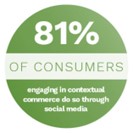Every year, new technology and trends emerge in the e-commerce industry. Chatbots, AI, and customer experience have all been hailed as game changers in recent years, with retailers keen to adopt them to improve their digital capabilities.
Still, consumers face:
- Multiple navigation steps
- Too many products to browse
- Lengthier checkout process etc.
However, what if there was a way to streamline the process while improving the consumer experience?
Enter contextual commerce. This revolutionary approach combines the finest of all applications into one seamless platform, eliminating the need to move between payment gateways and optimizing the shopping experience. However, due to the enormous quantity of e-commerce stores available, customer experience has degraded. This article will look at contextual commerce and how it is changing the face of e-commerce.
Pioneering the Future of Contextual Commerce in Retail E-commerce
As a thought leader in the e-commerce sector, it is imperative to stay ahead of emerging trends. Contextual commerce is one such trend that holds the key to delivering a truly exceptional user experience.
While there is still some ambiguity surrounding the precise definition of contextual commerce, the core principles of contextual commerce include
- Utilizing customer data to expedite the purchase process.
- Presenting products to customers within their preferred digital environment.
- Converting standalone technologies into multi-functional platforms, reducing transaction friction.
Sounds exciting, isn’t it?

Contextual commerce emerged a few years ago when social media platforms like Facebook, Twitter, and Pinterest provided commerce alternatives, allowing customers to purchase items, digital products, and services within their preferred digital environment. Customers no longer need to leave the website or mobile app, resulting in a more seamless shopping experience.
Leveraging the Power of AI and ML to Enhance Contextual Commerce: As artificial intelligence and machine learning continue to advance, the contextual commerce experience is poised to reach new heights of personalization, targeting, and engagement. By presenting products and services directly to customers in the context of their browsing journey, contextual commerce has the potential to revolutionize the e-commerce sector with a truly immersive shopping experience tailored to each individual.

Let us break down the positive and negative experiences with contextual commerce to better understand the appeal of retail e-commerce and how website merchants should approach it. Based on the Samsung Consumer Digital Survey, 68.9% of contextual commerce users reported a positive experience, while only 1.7% reported negative experiences. A further 29.4% reported “mixed” experiences. Overall, the experience has been engaging. This reinforces the need for businesses to increase customer buying opportunities at different touchpoints within the screen/page instead of redirecting consumers to an external website.
Consumers expect fast, easy, and frictionless shopping experiences in this modern era. Customers emphasize convenience, speed, context, and control, and contextual commerce ticks all these boxes.
The Importance of Third-Party Platforms in Contextual Commerce
I want to highlight the pivotal role that third-party platforms play in the realm of contextual commerce. The growing demand for omnichannel experiences and greater control over pricing and privacy is evident, with a quarter of consumers placing a premium on convenience in their shopping experience.
To effectively address these demands, third-party platforms must provide clear and easily accessible information about products, shipping, and payments while streamlining the process to engage users. This can be accomplished by deploying online payment wallets and ensuring user data privacy protection so that sensitive information is not shared with third-party platforms or participating e-commerce merchants.
In conclusion, contextual commerce is poised to revolutionize customers’ shopping habits in a way that has never been seen before. This shift can occur on various platforms, including social media sites such as Facebook, Pinterest, and Instagram, or through well-designed blogs, event and ticketing websites, and travel platforms.
By offering a personalized, targeted, and engaging experience through the use of AI and ML technologies, you can stand out from the competition and increase your customer satisfaction and sales.
With the right tools, contextual commerce can happen anywhere, and its popularity among early adopters bodes well for merchants and customers alike.
